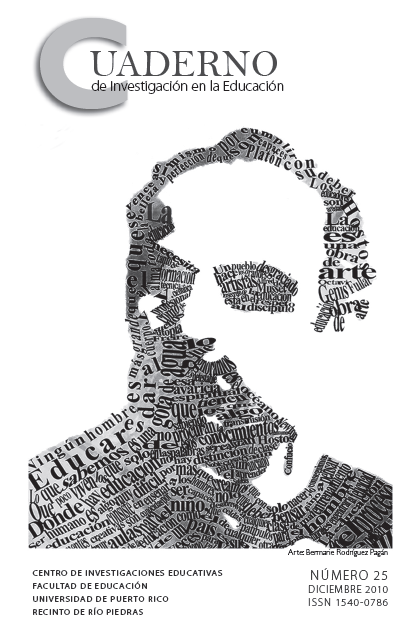Abstract
The communicative approach used in the last decades as a predominant pedagogic line in the teaching of foreign languages, implies, in its pure manifestation, a deliberate dismissal of certain teaching strategies in an attempt to develop the functional aspect of the language, leaving the direct instruction of the form behind. This article presents the need to reconcile paradigms and proposes the incorporation of different approaches and ways of thinking with the aim of attaining a more profound and efficient integration of the target language.
How to cite:
Pericot-Schenk, V. (2010). Hacia una visión más ecléctica de la enseñanza de la gramática en las lenguas extranjeras. Cuaderno de Investigación en la Educación, 25, 32-49. Retrieved from https://revistas.upr.edu/index.php/educacion/article/view/13534
References
Alderson, C., Clapham, C. & Steel, D. (1997). Metalinguistic knowledge, language aptitude and language proficiency. Language Teaching Research, 1(2), 93-121. doi: 10.1177/136216889700100202
Berns, M. (1990). Contexts of competence. Social and cultural considerations in the communicative language teaching. New York: Springer Verlag.
Krashen, S. D. & Terrell, T. D. (1983). The natural approach: Language acquisition in the classroom. Hayward, CA: Alemany Press.
Larsen-Freeman, D. (1997a). Grammar and its teaching: Challenging the myths. ERIC, 406820.
Larsen-Freeman, D. (1997b). Grammar dimensions: Form, meaning, and use. Boston: Heinle & Heinle.
Larsen-Freeman, D. & Long, M. (1991). An introduction to second language acquisition and research. London: Longman Group.
Levenston, E.A. (1985). The place of translation in the foreign language classroom. English Teachers Journal, 32, 33-43.
Levinson, S. (1983). Pragmática. Barcelona: Teide.
Littelwood, W. (1981). Communicative language teaching. Cambridge: Cambridge University Press.
Lynch, T. (1996). Communication in the language classroom. Oxford: Oxford University Press.
Meltzoff, A.N, Kuhl, P.K., Movellan, J. & Sejnowski, T.J. (2009). Foundations for a new science of learning. Science, 325, 284; DOI: 10.1126/science.1175626
Pienemann, M. (2005). Crosslinguistic aspects of processability theory. Amsterdam: John Benjamins Publishing Company.
Randall, M. (2007). Memory, psychology and second language learning. Philadelphia: John Benjamins Publishing Company.
Richards, J. C. & Lockhart, C. (1998). Estrategias de reflexión sobre la enseñanza de idiomas. Cambridge: The Press Syndicate of the University of Cambridge.
Richards, J. C. & Rodgers, T. S. (1986). Approaches and methods in language teaching: A description and analysis. Cambridge: Cambridge University Press.
Scarpelli, M. (2009, July 30). Social media‘s effect on learning. The Wall Street Journal. Recuperado de http://blogs.wsj.com/digits/2009/07/30/social-medias-effect-on-learning/
Schoenberg, I. (1999). Can a classroom be too communicative? TESOL Matters, 9.
Stulajterova, E. (2008). The place of translation in English language teaching. Humanising Language Teaching, 6.
Swain, M. & Canale, M. (1981). The role of grammar in a communicative approach to second language teaching and testing. Eric, 221026.
Von Elek, T. & Oscarsson, M. (1973). A replication study in foreign language grammar to adults. Research Bulletin,16, Eric ED094551.
Walker Tileston, D. E. (2004). What every teacher should know about effective teaching strategies. Thousand Oaks, CA: Corwin Press.
Wilkins, D. A. (1972). Linguistics in language teaching. Cambridge: The MIT Press.
Williams, M. & Burden, R.L. (1999). Psicología para profesores de idiomas. Enfoque del constructivismo social. Cambridge: Cambridge University Press.
The contents published in the Puerto Rico Journal of Education is freely distributed under open access practices, in accordance with the Creative Commons license, Attribution-NonCommercial 4.0 International (CC BY-NC 4.0). Through these principles, the journal and its authors allow readers to access, reproduce and share articles in full text. Users should give credit to authors in a reasonable way without suggesting they have their support. Under no circumstances, readers may make use of the contents for commercial purposes. The authors retain copyright on their works.

